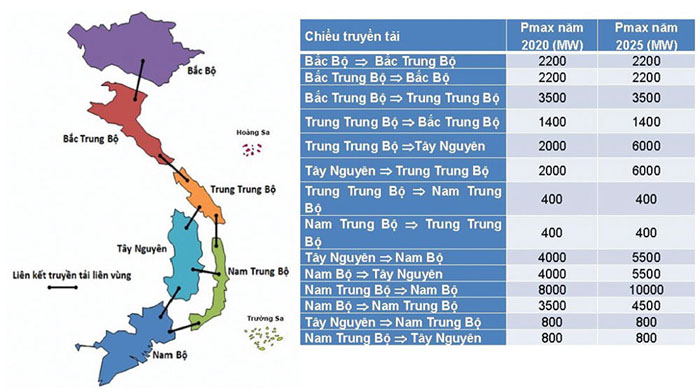According to a document published at the first seminar on the National Power Development Plan for the period 2021-2030 with a vision to 2045 held recently, it can be clearly seen that the transmission interface will be very large among six regions. Typically, power transmission from South Central to South Vietnam will be 8,000 MW (2020) and 10,000 MW (2025), from North Central to Center Central will be 3,500 MW, from Center Central to Central Highlands 6,000 MW, from Central Highlands to the South 5,500 MW, from South Vietnam to South Central Coast 4,500 MW.
According to statistics in 2019, Vietnam has more than 28,000 km of transmission lines with voltage levels of 220 kV and 500 kV, including more than 8,600 km lines of 500 kV. Vietnam's power transmission system in general and the 500 kV power system in particular currently rank 1st in Southeast Asia in terms of scale, followed by Thailand with about 6,000 km of 500 kV transmission lines.
It is estimated that 1 km of 500 kV line will generate 1 MVAr of reactive power, increase in 500 kV grid will raise the amount of reactive power generated on the system, leading to the need to install additional voltage adjustment devices such as reactors, capacitors in order to maintain the voltage level on the grid within permissible limits.
In 2019, the power energy transmitted by the 500 kV transmission system was about 90 billion kWh. With an energy loss rate of about 1.95%, the loss of energy would be around 1.76 billion kWh, equivalent to one fifth of Son La Hydropower Plant’s electricity output. If the power loss on 500 kV transmission lines is estimated at about 0.5%, 10,000 MW transmitted in one hour would make a loss of about 50 MW, equal to the capacity of a medium sized solar power plant.
With a large transmission power between regions and many 500 kV circuits, the risk of breakdown on the 500 kV circuits will increase. Any faults if occurred will be very serious since a large volume of power being transmitted through the remaining circuits would cause overload, affecting the protection system and leading to a risk of grid collapse (blackout).
Thus, it is obvious that in addition to advantages of power transmission in long distance, with large amount, the increasing development of 500 kV power system will cause difficulties in voltage regulation, higher power loss and impose a greater risk of losing safety and stability on the power system.

Transmission flows and economic zoning in the draft PDP VIII
It can be perceived in the draft Master Plan No. 8 that Vietnam paid a great attention to strongly developing a 500 kV network to evacuate power from power generation centers far from load centers. In fact, although the scale of the power system in Vietnam ranks 1st in Southeast Asia in terms of transmission grids and 2nd in power generation capacity (after Indonesia), the efficient use of electricity for economic development in Vietnam still lags behind many countries in the region.
It is the inefficient use of electricity that puts Vietnam under pressure to invest in developing power generation and power grid facilities with high annual growth rates of 9% to 10% on average, causing investment pressure on both the Government and the power sector.
The ineffective use of electricity has been caused by many factors, including the ones related to: Inappropriate economic structure: Some industries consume a lot of energy, not taking advantage of low electricity price to produce and export energy intensive products (such as steel, clinker, etc.); Wasteful use of electricity is still popular in many areas, etc.
Coordination of urban, regional economic development plans: The robust economic development at the two ends of the country (the South and the North), the inconsistency between the economic development planning and the power development planning, have led to the fact that load centers are located far away from power generation centers, leading to long distance transmission of electricity at high voltage and with big losses.
In order to ensure the efficiency of PDP 8, it is necessary to coordinate urban, regional economic development plans, to plan economic zones and urban centers close to power generation centers. Thereby, a reduction of investment in 500 kV networks and development of transmission grids at a voltage lower than 500 kV should be considered. At the same time an economic restructure towards less energy consumption is strongly recommended.
In the process of formulating Power Development Plan VIII, the consultant should make counter-arguments against regional and urban economic development plans to reach a coordination in a balanced economic development throughout the whole country, achieving the country's goal of optimal economic development.
evn.com.vn
Share